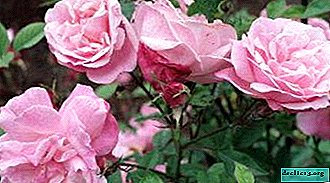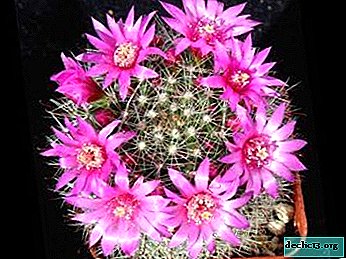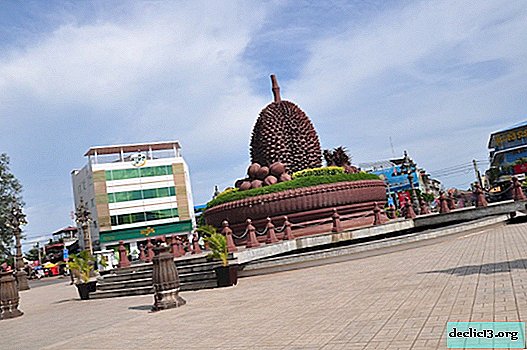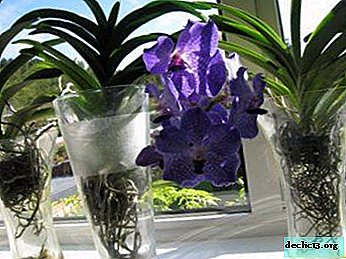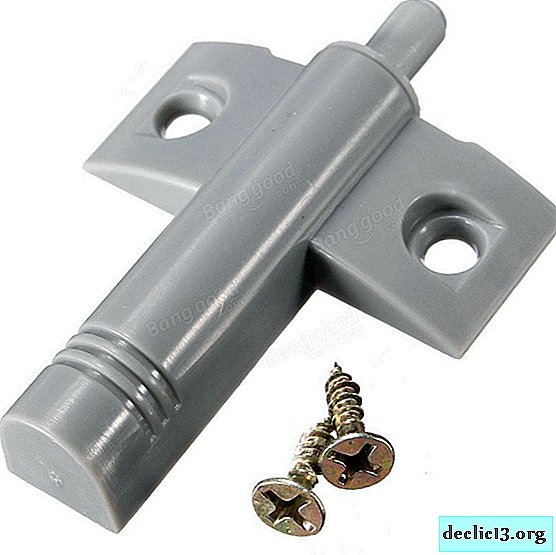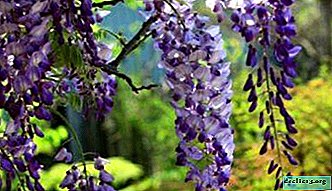Poisonous tropical guest in the house - euphorbia trihedral: description, benefits, harm and care of the plant
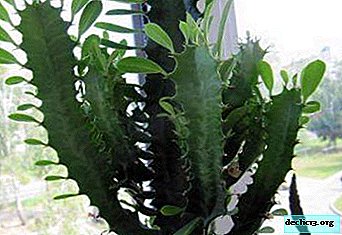 Euphorbia trihedral - plant - giant. Large and hardy hybrids are widespread among lovers of tropical exotic plants. It is easy to care for, not picky about soils, drought-resistant representative of the tropics.
Euphorbia trihedral - plant - giant. Large and hardy hybrids are widespread among lovers of tropical exotic plants. It is easy to care for, not picky about soils, drought-resistant representative of the tropics.
Next, we will tell in detail about the features of this succulent, how the variety differs from representatives of its family. How to care for the plant: the required temperature, watering, light, pruning, than to fertilize. Learn about breeding methods.
Names, botanical description and features and photos
Differences Euphorbia Trigona in the scientific community is usually called Euphorbia Trigona (Euphorbia Trigona). In everyday life, the plant has many other names - triangular euphorbia, exocactus, Mexican cactus. This stem succulent belongs to the numerous Molochaev family.
The homeland is considered South Africa, Madagascar, subtropics of America. The flower is large, has a thick stem with three faces. In nature, grows up to 6 - 8 m, in room conditions reaches 2 - 3 meters in height.
The variety is branched, over time, overgrows with rich shoots. The ribs of the stems are clearly defined, covered with small spines. The stems are bright green in color. The leaves are small, 2-3 cm long, oblong in shape, located at the very top of the fleshy stem. Leaves are not saved, quickly fall off, new processes grow in their place. This perennial does not bloom.
Reference. Tropical exot is characterized by rapid development and growth.Often grown in offices and other official institutions, on verandas and enclosed loggias.
Look at the euphorbia trihedral in the photo:




Is the plant poisonous and can it be kept at home?
The flower is decorative, it is possible to grow it as a houseplant in the house, observing safety measures. If, nevertheless, the juice gets on the skin, it is necessary to immediately rinse the place of contact with running water. Prednisone ointment will help relieve itching and reduce the painful reaction.
It is not recommended to grow this exotic if there are small children or animals in the house. You can not install pots in the bedroom, this variety exudes a mild aroma that affects sleep and the nervous system as a whole. Florists note that in such cases, sleep becomes short and disturbing.
Is this poisonous flower a cactus or not? Some install pots next to a computer to absorb harmful radiation. This is an erroneous opinion, triangular euphorbia is not a cactus. Although many call it a cactus - Mexican. The variety has only external similarities; there are no biological family ties with cacti.
Benefits, harms and contraindications
It is believed that the flower cleans the air of harmful microbes, absorbs carbon dioxide well and unpleasant odors. In addition, the plant is widely used as a medicinal raw material in pharmacology.
The root contains starch, ascorbic acid, tannins, resins that have anti-inflammatory effects on the body. These components are part of many antitumor, blood-purifying, stimulating drugs. Milk juice is part of ointments and tinctures for removing warts, calluses and treating fungal skin lesions.
Important! Doctors warn that you can not self-medicate. All drugs should be taken only as directed by a doctor.It must be borne in mind that the juice of the flower is very toxic, an overdose leads to serious consequences: it causes nausea, vomiting, upset intestines, serious poisoning of the stomach, heart failure. Allergy sufferers are not recommended to use tinctures and baths for a long time, an exacerbation of inflammation of the skin and mucosa is possible.
Do not allow these drugs to get into your eyes or open wounds. The use of the medicine during pregnancy is contraindicated. Juice must not be allowed to enter the tongue or mucous membrane. The tongue and face begin to go numb, blisters, wounds and non-healing ulcers may appear.
How to care for a trihedral view?
Temperature
An unpretentious milkweed variety develops beautifully from spring to autumn at ordinary room temperature, it is not afraid of a temperature increase to 25 - 28 ° С. In winter, the permissible temperature is up to 16 - 18 ° C.
Watering
 Watering this species should be moderate, in small doses. In summer, once a week is enough. In winter, watered only when the topsoil is completely dry. With cool contents, water should be watered once every 3 to 4 weeks.
Watering this species should be moderate, in small doses. In summer, once a week is enough. In winter, watered only when the topsoil is completely dry. With cool contents, water should be watered once every 3 to 4 weeks.
A flower loves spraying and bathing in the shower. This procedure removes unwanted dust from the stems. During the procedure, it is recommended to close the soil layer with a film.
In the autumn-winter period, dust is usually brushed off with a special soft brush.
Shine
Euphorbia trihedral grows well in sunny places. Although it is better to cover the windows with light shading during intense sunshine. It is permissible to grow succulent in partial shade. To the rays of the direct sun the flower is taught gradually. In summer, pots are best installed on the veranda or balcony, the flower likes fresh air.
Recommendation. Pots should be rotated from time to time so that the sun falls equally on all sides.Pruning
To control the growth of the tops of triangular milkweed, cut in the spring. Also, to cut off the children during reproduction, the plant is pruned. Pruning contributes to the emergence of new shoots. The bushes become lush, the stems branch well.
Florists put on tops of special hats - bottle caps. Then the bush develops only wide.
Top dressing
Fertilizers must be special - for succulents or cacti. Top dressing is introduced from spring to autumn through irrigation.
Pot
The pot for this grade requires a roomy, but not too deep - for drainage and weighting. Powerful stems can overturn the pot, damage the superficial root. The flowerpot is changed every 2 to 3 years, increasing it in diameter by 3-4 cm.
All the details of caring for this type of milkweed can be found in a separate article.
Breeding
Seeds
 At home, this method is not used. Hybrid specimens do not produce seeds. In laboratory conditions, sowing is done in early spring. The process is long, laborious, not practical.
At home, this method is not used. Hybrid specimens do not produce seeds. In laboratory conditions, sowing is done in early spring. The process is long, laborious, not practical.
Landing pattern:
- Seeds are pressed 1 to 2 cm deep at a distance of 20 cm from each other.
- The substrate is moistened.
- Shoots appear after 2 weeks.
- Young seedlings take root easily.
- Air temperature - at least 20 - 22 ° C.
Cuttings
This method is considered the most acceptable for triangular milkweed. Cuttings are cut from the upper shoots up to 10 cm long or the side shoots are cut off - children. The time for grafting is spring or summer.
The procedure is simple, the cuttings take root quickly:
- Chopped shoots are washed with warm water to stop the juice.
- Within 2 to 3 days in the shade, the cuttings wither.
- Slices are processed by crushed coal.
- Shoots go deep into sand or perlite.
- Capacities are exposed to a bright place.
- The temperature of the cuttings is 22 - 25 ° C.
- After rooting, young seedlings are transplanted into permanent pots by transfer.
Division
For reproduction use the method of division of the stems. The procedure is carried out in the spring.
Important! each separated part must have a root part with a stem.Necessary soil composition for planting the separated parts:
- orff - 1 hour
- Sand - 1 hour
- Leaf, turf land - 1 hour each.
- Drainage layer - broken brick, pebbles, expanded clay.
 Division Procedure:
Division Procedure:
- The substrate in a pot is well moistened.
- A uterine plant is obtained, dry and damaged root processes are removed.
- Sections are treated with activated carbon.
- Separated parts are planted in separate pots.
- Watering is moderate, the air temperature is at least 18 - 20 ° C.
All effective triangular milkweed breeding methods are described in this article.
Briefly about the diseases characteristic of this flower
- If the leaves turn yellow, the flower lacks mineral fertilizing.
- Excessive watering or inappropriate substrate leaves fall. It is better to transplant a flower, add a drainage layer.
- The leaves began to dry - you need to remove the pots in a cooler and shaded place.
Triangular euphorbia is practically not affected by pests. But in violation of care and hygiene, a spider mite, aphid may appear. When the soil is damp, powdery mildew appears. The treatment of the bush with special insecticides will help here.
Euphorbia triangular, in spite of its "poisonousness", is distinguished by its beauty and outstanding appearance. Observing the simple rules of care, you can grow real tropical bushes - giants.



